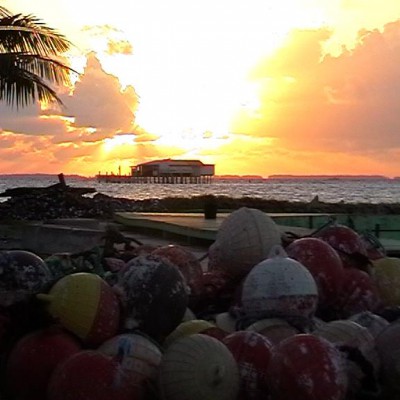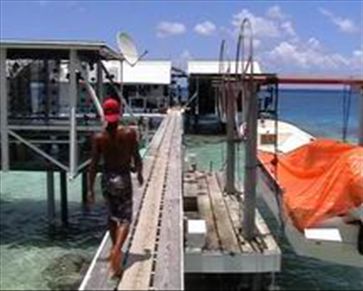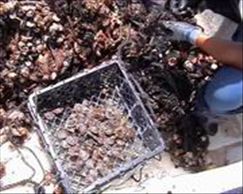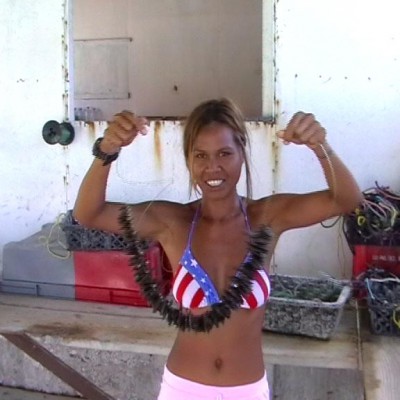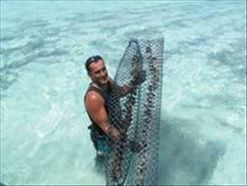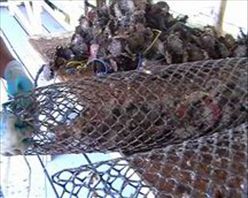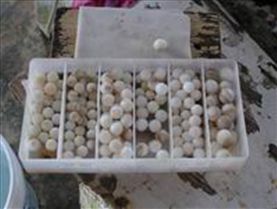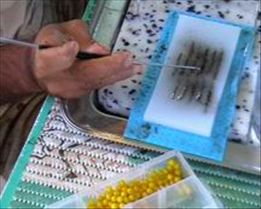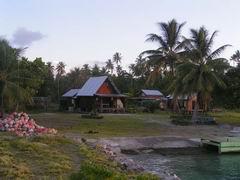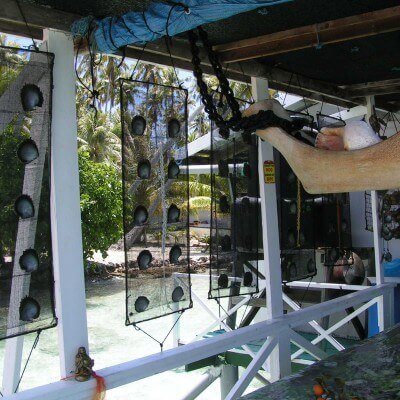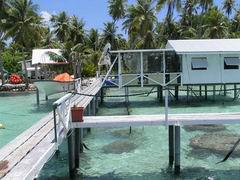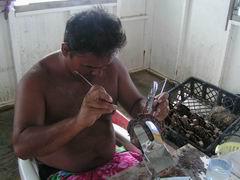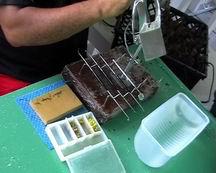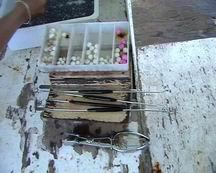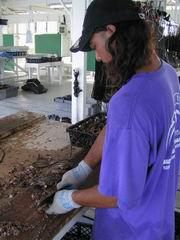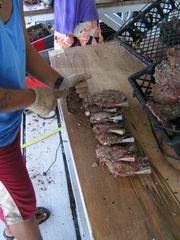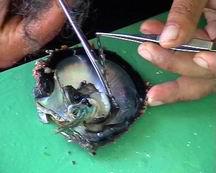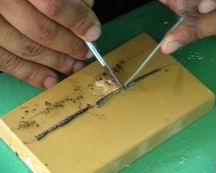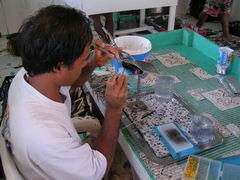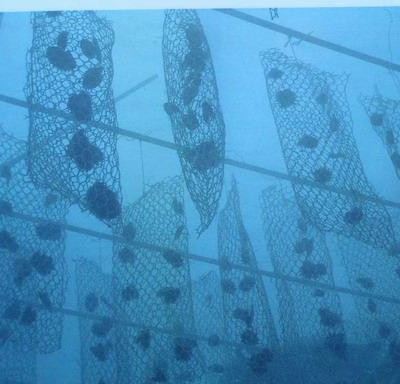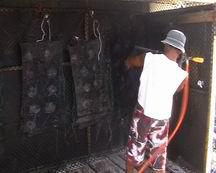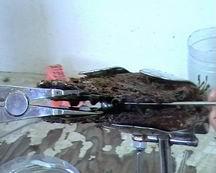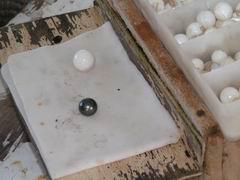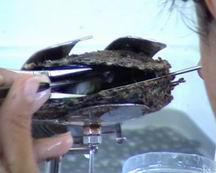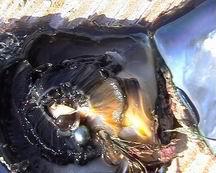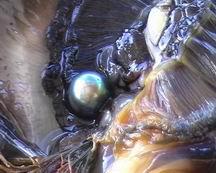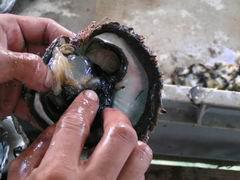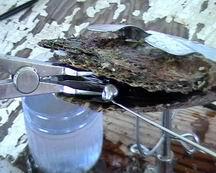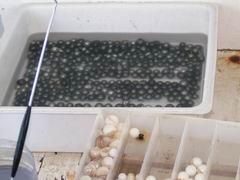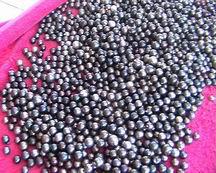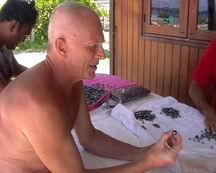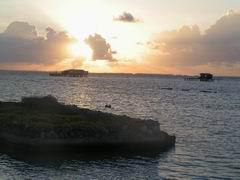Tahitian pearls are cultured on the low-lying coral atolls of the Tuamotu and Gambier Archipelago. The coral deposited on the summit of volcanos extincted millions of years ago. These atolls look like a champagne glass: outside the open sea, inside the shallow (30-40m deep) lagoon and the people live on the narrow rim. Of the 400 atolls in the world there are 84 such atolls in French Polynesia.
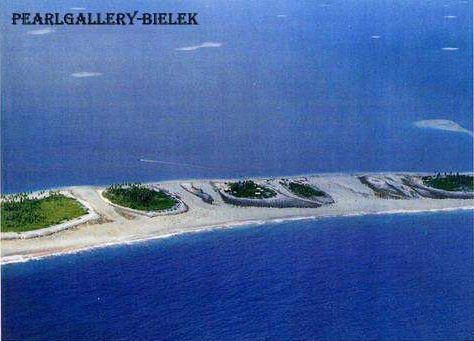
The nutrient-rich waters of the lagoons ensure favourable environment for development of the oysters. The nutritive substances rich in plankton and mineral salts come from great depth of the sea. There are atolls with an opening to the sea and there are closed ones with narrow and shallow channels. In both cases the seawater can get in from the sea bringing the nutriment for the oysters.
What is required for culturing Tahitian pearls?
Oysters, more exactly a great amount of black-lipped oysters, Pinctada margaritifera Cumingi. Since the wild oyster population has been depleted, the spats have to be collected and cared until they are two years old. For this end special collectors (synthetic fibre) are used on which the spats attach themselves. The collectors are suspended on long ropes hold on the water surface by great number of buoys. The collectors are hauled up after 8-9 months. Beside the young black-lipped oysters there are also lots of other creatures clinging to each other and the collectors. Most of these little oysters and shellfish have to be removed and the wanted ones are sorted and cleaned.
Next the young black-lipped oysters are placed in a long cylindrical basket made of plastic coated wire net (called chicken-wire) in order to protect the valuable content from predators such as blowfish, octopus, the cliona sponge, shell-boring mollusks, etc.
Nucleus. Traditionally an American freshwater mussel has been the best bead material for this purpose. These are the so-called pig toe mussels found in the Mississipi river. First the shell is cut into cubes then ground with stone fragments until they are round. Unfortunately this mussel is getting scarce thus the pearl farmers try to find another source (eg. freshwater mussels from different rivers in South-East Asia) but so far these efforts have not been too successful. The nuclei are available in different sizes from 6 to 12mm. Recently the Japanese scientists have developed a gene-treating technique for the nuclei. Using such yellow nuclei the rate of rejection is more favourable.
Pearl farm facilities. These consist of a grafting shack where all the main activities: cleaning, boring, grafting, harvesting and short-time storage of the oysters are carried out. The shack is usually erected on piles in the shallow lagoon. Furthermore a certain area of water is needed for the long lines (ropes) fixed by buoys on the water and by concret blocks to bottom of the lagoon. These long lines serve for holding both the spat collectors and the oysters between grafting and harvesting period. Buildings on land are needed for storing all the materials, equipment, tools and the personnel. Generators and/or solar panels with high capacity batteries for electricity and big plastic tanks to collect rain water, boats and fuel-tanks for gasoline are required as well.
Grafter or technician. Since the beginning of pearl culturing (1962) in French Polynesia the grafting was performed only by Japanese technicians for 20 years. Though they were very jealous of their secrets, more and more Polynesian were able to acquire this knowledge not written in books and not taught at school. They need to know perfectly the oyster anatomy, they need to be patient and very skillful. In order to master this technique lots of thousands of oysters have to be sacrificed.
And now let us take a look at the first grafting. It is a real surgery and beside the knowledge and manual skill it requires special tools.
The oysters to be grafted are removed from the long lines and brought to the grafting shack. They are cleaned, growths and parasites are removed. One of the workers opens the shell slightly with a special device and inserts a wedge.
For the first grafting an oyster has to be sacrificed. It must be a healthy one with the desired peacock colours of the mother-of-pearl. After the grafter fully opens the oyster, with scissors he cuts a 5-10 cm long and 2-3 mm narrow stripe from the brim of the mantle then streches it on a wooden board and with a slicer he cuts it into 2-3 mm tiny pieces. These are the epithelial tissues which are going to secret the nacre around the nucleus. One donor oyster can yield enough epithelium for grafing 50-60 oysters and it is important to keep them wet.
In the meantime one basket is packed with the „pre-stretched” oysters and they are brought to the grafter. He grips the first oyster, places it into the shell holder and inserts a spreader with ratchet between the valves of the oyster. After having found the gonad the grafter makes a small incision in it and inserts a graft (piece of epithelial tissue) then a nucleus into the small cavity. It is important that the nucleus is positioned against the graft. A requirement that sometimes cannot be checked by eyes, it needs an incredible skill.
Then he removes the spreader and puts the oyster back into the basket. The actual operation period is less than one minute. One more action before immersing them into the water: two small holes have to be drilled in the hinge of the oysters and with a plastic string they are attached to a coloured rope or into a kenguru basket. Since the oyster can survive out of seawater only for a short time, they have to be put back first into the shallow water under the grafting shack then the following days they are carried to the long-lines where they are going to stay two years.
What is going on after grafting?
Unfortunately lots of oysters do not survive the operation and lots of them reject the nucleus. Using gene-treated nuclei this rate has been improved. If the grafting was successful, a unique process is taking place in the gonad of the oyster: in the first month the epithelium grows and encases the nucleus thus forming a so-called pear-sac around it. This pear-sac is going to secrete and deposit the nacre made of protein and calcium-carbonate crystals called aragonite in concentric layers around the nucleus. Thickness of these layers moves between 0,3 and 1,0 micron and just like the fineness, it is mainly up to the water temperature. When the incision on the gonad heals quickly and the sac covers the nucleus completly, there is a good chance that a nice round pearl is formed. If not, the nacre layers will be deposited in some irregular fashion producing pearls of different shapes like semi-round, semi-baroque or baroque.
Pearl harvest
If no hurrican or virus has devastated the oysters, the most exciting phase of pearl culturing is arriving, it is the harvest. At this time it turns out if the invested work and money will be crowned with success. The harvesting process is much like the grafting: oysters detached from the long-lines brought to the pearl shack where they are cleaned and presented to the grafter.
There are three possibilities:
- a pearl is in the transparent pearl-sac
- though the nucleus had been rejected, a keshi was formed
- neither pearl no keshi is found
For removing the pearl generally the same incision is made in the oyster’s gonad like when grafting. The grafter applies a slight pressure on the sac thus the pearl delivers. The pearls are kept in a dish filled with water. If the pearl is a nice round one and the oyster is judged healthy, a new nucleus -somewhat bigger than the pearl just taken out- can be selected and replaced into the pearl-sac. This process is called the second graft following the third one a year later.
On the left: the oysters are brought to the grafting – shack.
On the right: Oysters in kengooru basket are cleaned with high pressurised water.
- Pearl is removed from the pearlsack
- Nice round pearl was born
- This nucleus above will be placed into the pearlsack
- Nucleus is on the way…
- Nucleus is already in the pearlsack
Sometimes when the nucleus is rejected but the epithelium remains in place, the secretion process is accomplished and the oyster delivers a keshi. Its whole structure is nacre (mother-of-pearl) developed in baroque shape.
If neither pearl no keshi is found in the oyster but it is healthy, it can be regrafted, if not, it is sacrificed. The shells are collected and sold. In addition to mother-of-pearl buttons lots of costume-jewellery articles are produced of them.
Pearls are selected according to size, shape and quality
It is recommended to observe the efficiency of an average pearl farm in French Polynesia.
Let us begin the cultivation process with 10.000 young oysters. Around 5.000 oysters will die due to natural mortality or predators and 500 pieces are not suitable for grafting. 500 oysters will die after grafting and 1.500 will reject nuclei. As of now 2.500 grafted oysters have remained. Additional 500 oysters will die in the course of the cultivation period. Result at the harvest: 2.000 pearls of different quality, shape, size and colour. If the rate of A-grade (high quality) pearls is 10%, and that of the round pearls is 25%, the pearl farmer has 50 high-grade round pearls of different sizes and colours. The question is whether a strand could be compiled out of them. Certainly not, not even a pair for earrings.
Of course there are pearlfarms with more favourable results, while there are others with worse data.


